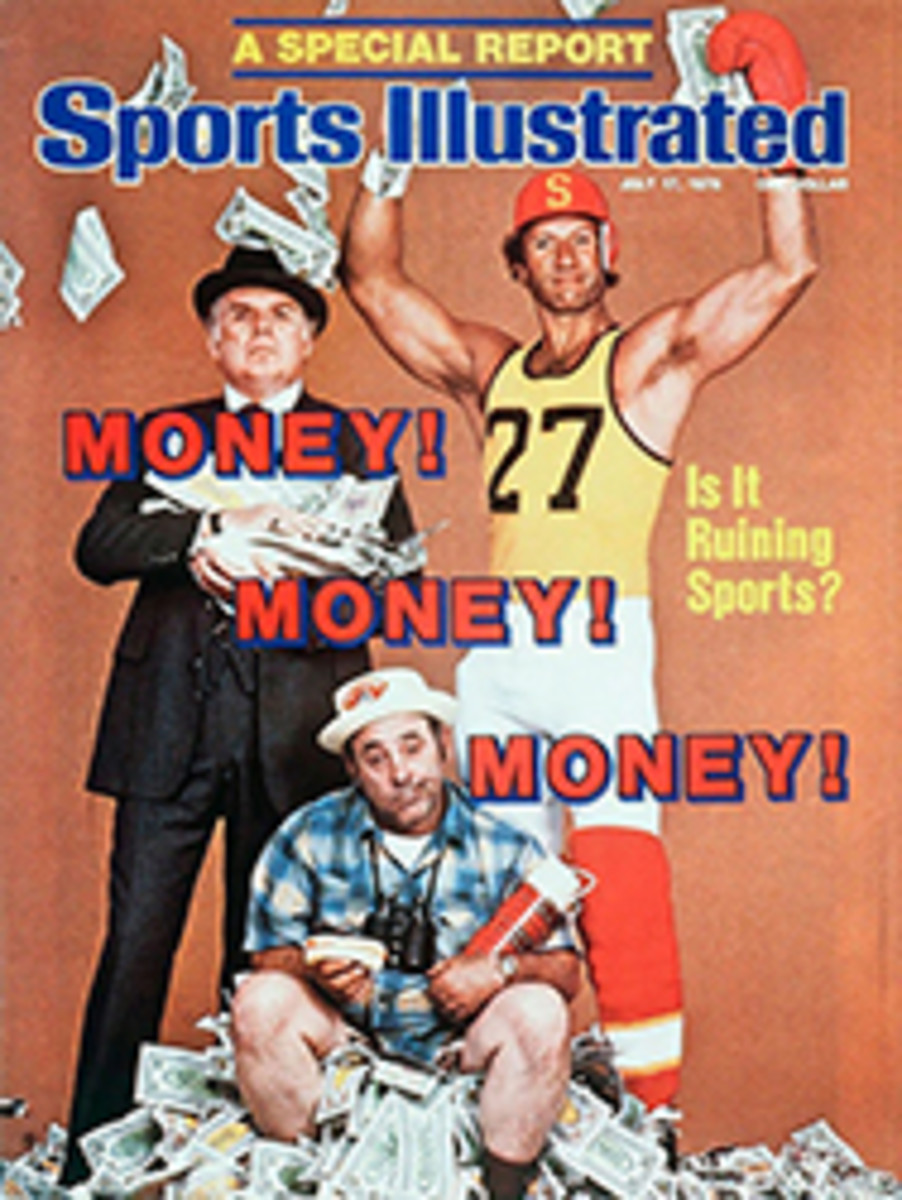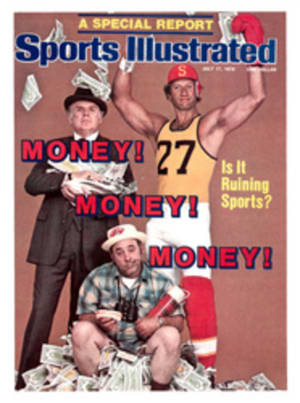
7 THE VERY OLD SUCKER PLAY
FACT: Pro teams are subsidized by taxpayers.
In ancient Rome, stadiums were financed by taxes levied on brothels. It was not that the feed bills for the lions were too high—Christians being a glut on the market—nor a question of whether celebrity gladiators would draw all that well. No, stadiums had to be subsidized because they were so inherently unprofitable that no private investors would touch them, least of all the sports promoters. Their money was tied up in superstars like Diodes, a free-agent charioteer who switched stables for a cool 31 million sesterces ($1.8 million). "Decent men groan," wrote some Roman Ring Lardner, "to see this former slave earn an income that is 100 times that of the entire Roman Senate."
Nothing has changed except that today every taxpayer, be he panderer or prude, foots the bill for his local Colosseum. Stadiums still lose money and decent men still groan, some of them on the floor of the United States Senate.
Four months ago, Senator William Proxmire denounced as a "knucklehead-ed ripoff" a deal allowing the Yankees to pay only $170,681 in rent to New York City last year, on a gross of $13.4 million. What the Wisconsin Senator neglected to mention is that his state's major league baseball team, the Brewers, pays only $1 in rent on the first million admissions to Milwaukee County Stadium and only 5% of its gross on the next half million. Last season, with an attendance of 1,114,938 and an average ticket price of $3.68, the Brewers paid the county a mere $21,149, which is perhaps the lowest rent in professional sports. Fact is, all but a few of the teams that perform in public facilities enjoy sweetheart leases that would make Shylock blush.
It is estimated that by charging low rents, forgoing property taxes and paying the stadiums' operating losses, local governments subsidize teams by more than $25 million annually. While some leases involve tricky sliding scales, the average team pays slightly less than 10% of its home gate receipts. Here is a rundown on the rents some teams pay:
[originallink:10598056:70789]
In some cases the disparities are offset by other compensations. For example, the Chiefs retained a small percentage of the proceeds from concessions, parking and souvenirs, while the Pistons, who in 1977-78 were in the last year of a contract at Cobo Arena that required them to pay only $2,000 a game, received no income from concessions or parking.
Regardless of the details of the deals between the teams and the landlords, this fact holds true: 70% of the stadiums and arenas used by pro franchises have been built with public funds, and they are piling up an indebtedness that will cost taxpayers some $6 billion through the turn of the 21st century.
Nevertheless, even while construction costs have kept soaring, so, too, has the mania for more grandiose playgrounds. In 1965, Atlanta-Fulton County Stadium was completed at a price of $314 a seat; in 1970, Pittsburgh's Three Rivers Stadium came in at $700 a seat; and in 1975, New Orleans' Superdome cost $2,333 a seat. Operating losses have risen accordingly, and only one public facility, Anaheim Stadium, home of the Angels, claimed a profit ($758) last year. That occurred only because of the income from rock concerts.
There is a rationale for the profligacy. When future archeologists dig along the banks of the San Antonio River, they may unearth the remains of the Convention Center Arena and some of the 6,000 seats that are being added at a cost of $3.7 million. "Aha!" one of the diggers will exclaim, "this was a big league city!" That, at least, seems to be the hope of San Antonio Mayor Lila Cockrell, who is typical of stadium boosters all over the country. In agreeing to a lease that required the Spurs to pay only $500 a game last season—a figure that will gradually increase to $2,400 in 1986—her honor admitted that it was a partial subsidy, but added, "We have a great opportunity in this city through the gaining of national stature on the sports scene. This will help attract industry and assist our economy."
Yes, ma'am. And that's why the Houston Chamber of Commerce has said, "We know of almost no case in which the Astrodome was a factor in a business moving to Houston."
Which is not to say that athletic facilities have no positive impact. Like any industrious society, 20th-century America is bent on erecting monuments to itself. The great railway stations of the 19th century have been superseded by stadiums that look like steel-belted radials lying on their sides. As an extra, some even come complete with hubcaps. Though hardly works of art, they are nonetheless imposing symbols of civic pride and the old can-do spirit. And the Age of the Stadium does contribute to the sporting and economic vitality of a community. As the late Hubert Humphrey once said, without the action at Metropolitan Stadium, the Twin Cities would be a "cold Omaha."
Recent surveys estimate that the Blue Jays' first season at Exhibition Stadium pumped $66 million into the Toronto economy, while the Pirates and their Three Rivers digs generate $21 million annually. "A stadium has to be thought of in more terms than whether it is self-financing," says Expo President Charles Bronfman. "It has to be thought of in terms of what tourist dollars and additional revenue it brings into a city. And in those terms some taxpayer subsidy is warranted, because it does return money and jobs to people."
That's what the former executive director of the Superdome, Bernard Levy, kept saying, even while his stadium showed immense losses. The Superdome had a whopping $11 million deficit in fiscal 1977. Following the Super Bowl bash in the city. Levy exclaimed, "We estimate conservatively that the impact of the Super. Bowl on our economy was $25 million to $35 million."
Louisiana voters can be forgiven if they are wary of the numbers game. After all, the modest $35-million, "self-supporting" football stadium that they approved in 1966 turned out to be the "world's largest indoor people-gathering place" with a price tag of more than $300 million, including $130 million in interest charges. Though extravagant in the extreme, the Superdome epitomizes a pattern that has evolved in other cities seeking the big league imprimatur. Understated price. Overstated revenues. Glowing promises. Political maneuvering. Charges of irregularities. Legal roadblocks. Cost overruns. Work stoppages. Delays and more delays.
The citizenry's edifice complex can easily be exploited by teams, and Buffalo, New York and Baltimore are exhibits A, B and C.
The Bills set the pace in 1964 when they threatened to leave town if Civic Stadium was not enlarged. The city complied. In 1970 the NHL Sabres took up residence, but only after the city agreed to add a $12-million balcony to Memorial Auditorium. In addition, the Sabres were granted a generous lease, half the concessions income and free use of the arena's offices. In return they agreed to pay their own telephone bills.
In 1971 the Bills announced that they had "no alternative to moving" unless a new stadium was built. Lest there be any doubt about the seriousness of the team's intentions, it was also made known that owner Ralph Wilson was threatening to go to Seattle and negotiate a transfer. The Erie County legislature gave in, and while Buffalo was still paying for the enlargement of Civic Stadium, the Bills moved into the new $23.5-million Rich Stadium. Says Leslie Foschio, the city's corporation counsel, a "host of serious problems," such as garbage disposal and law enforcement, "were put on the back burner so a major league stadium could be built. The psychological pressure leaves municipalities at a team owner's mercy and with one choice—pay the owner's price for a stadium or get whipsawed."
The Yankees used their cutting edge to good advantage in 1971 by threatening to follow the NFL Giants to New Jersey. They got the city to remodel Yankee Stadium, a job that was supposed to cost $24 million but exceeded $100 million when it was all done.
When George Steinbrenner bought the Yankees from CBS in 1973, the deal included a freshly drawn lease with a humdinger of a clause that allows the team to deduct stadium maintenance costs from its rent. In 1976, when the Yankees grossed $11.9 million in gate receipts and concessions, they theoretically should have paid the city $854,504 in rent. Instead, after maintenance was deducted, the city ended up owing the Yankees $10,000. Mayor Ed Koch recently made an appeal on the grounds of "decency," saying that in view of the city's financial plight, "It would be nice if Steinbrenner said, 'We made some and we're going to give some back.' " Steinbrenner replied, "A lease is a lease."
Except in Baltimore, where the Colts, who are opposed to renegotiating players' contracts, nevertheless demanded in 1976 that their Memorial Stadium lease be rewritten. The city not only went along, but also approved a unique two-for-one contract in which the Colts and Orioles pay the same rent. Previously each team had paid a flat 7% of its ticket sales; now the Colts and Orioles figure their rents, and whichever is the lower is the amount that each team pays. As applied retroactively in 1975, the formula allowed the Colts to ante up only $53,000, instead of the $217,000 they would have owed under the old rental deal.
And the beat goes on. In Minneapolis the Vikings and the Twins are pressing for a new $55-million dome, and in Boston Mayor Kevin White is backing a proposed $35-million arena that "would pay for itself." In Seattle, boosters drumming for the construction of the Kingdome brought in luminaries such as Mickey Mantle to back up their claims that the stadium would be a civic asset that would host the "world's most famous entertainers, Presidents of the United States and the great religious leaders of our time." Last week King County won a breach of contract suit against the company that originally signed up to build the King-dome. The $12.3 million award from that action will cut the stadium's price to about $47 million—a mere $7 million more than the original estimate.
ILLUSTRATION
JOHN HUEHNERGARTH
In ancient Rome, stadiums were supported by a tax levied on brothels.

